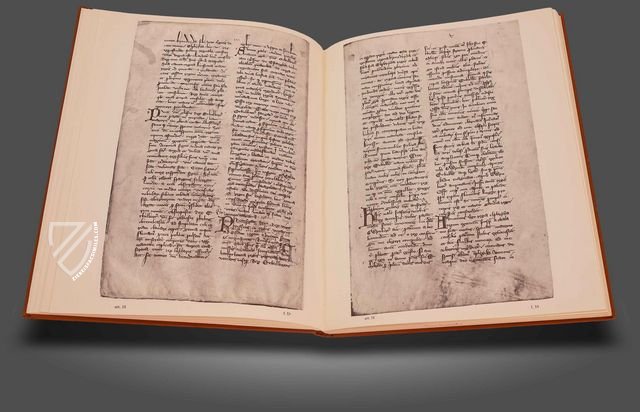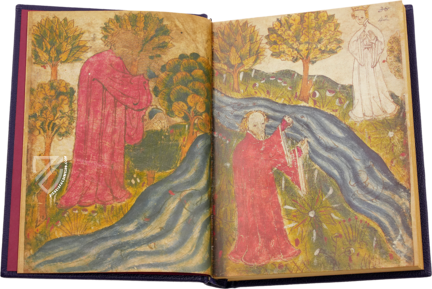The Harley Lyrics
(under 1,000€)
Created ca. 1340, the so-called Harley Lyrics is a compendium of religious and secular poetry that is considered to be one of the most important surviving English medieval manuscripts due to the rarity, quality, and abundance of this unrivalled collection. It was written in Gothic cursive by the skilled hands of three scribes and can be divided into two parts. Part I consists of a collection of hagiographical texts written in Anglo-Norman while Part II consists of miscellaneous secular and religious texts in Middle English, Anglo-Norman, and Latin. Numerous red and blue initials adorn the text, which also has various blank spaces for initials indicating that the decoration of the manuscript was never completed. The coveted manuscript was owned by numerous bibliophiles before being acquired by the British Library as part of a larger collection in 1753.
The Harley Lyrics
Once owned by and named after the famous bibliophile Robert Harley (1661–1724), this coveted mid-14th century manuscript is famous for being the earliest collection of secular and religious lyrics – short poems – written in Anglo-Noman, Middle English, and Latin as well as comprising more than half of the secular lyrics written before the 15th century. It is also prized for containing three hagiographies of Anglo-Saxon saints and four fabliaux – comical and bawdy minstrel tales from northeast France – as well as biblical stories, pilgrim guides, and interpreted dreams. Other works give insights into daily life such as compilations of common sayings, conduct literature, political songs, satires, and comedies. The sheer scope and variety of texts preserved in the manuscript, which is a cross between a miscellany and an anthology, make it one of the most precious English medieval manuscripts that has survived to the present.
The Ludlow Scribe
The manuscript has been dated to ca. 1340 although many of the texts are much older. There is evidence of three hands but only one is identifiable, albeit still anonymous, the so-called Ludlow scribe, who is responsible for copying most of the text. While scribes A and C are completely unknown, scribe B has been identified in three manuscripts and 41 legal writs. Like most medieval scribes, he is identifiable only by his characteristic handwriting. He is assumed to have been a successful professional legal scribe and chaplain working in the vicinity of Ludlow in Shropshire between 1314 and 1349.
Evidence of the Ludlow scribe’s formal education in Latin, religion, and law combined with his taste for secular performance pieces indicates that he may have been a private chaplain in a manorial household. In this role, he would have been responsible for providing his noble employers with spiritual guidance, legal advice, and entertainment while also educating and teaching manners to their male heirs. Evidence suggests he may have perished during the Black Death, which afflicted England from 1348 to 1350.
Making Sense of the Manuscript
The contents of this codex can be maddeningly hard to comprehend when read from beginning to end because it was not organized that way a modern book would be and is rather chaotic and random instead. That being said, the delineation of internal booklets, seven in total, has been helpful in distinguishing both the scribes and the potential organization of the contents. Some scholars have argued that there is an overarching metanarrative for the anthology that juxtaposes successive texts with one another’s narrative or viewpoint. However, this relationship is not always clear in booklet three and requires a knowledge of the sources used by the scribe.
In the fourth booklet, the relationships between the texts become clearer. For example, it begins a hagiography of St. Ethelbert, an Anglo-Saxon king who was martyred by pagan Vikings, which is followed by the tale of Simon de Montfort, leader of the Second Barons’ War who ruled briefly as de facto ruler of England before being defeated and killed by the forces of King Henry III at the Battle of Evesham on August 4th, 1265. He is presented as a martyr against the tyrannical overreaches of royal power similar to Thomas Becket, which reflects local sympathies for the barons’ cause in opposition to petty, corrupt rule and arbitrary taxation.
Codicology
- Alternative Titles
- Harley 2253
Henri d'Acre: Miscellany of secular and religious lyrics
Miscellany of English, French, and Latin works
Miscellany of the 'Harley Lyrics' - Size / Format
- 284 pages / 29.0 × 19.0 cm
- Origin
- United Kingdom
- Date
- Late 13th century – first half of the 14th century
- Epochs
- Style
- Script
- Gothic Gothic cursive
- Illustrations
- Red colored initials
- Content
- Collection of hagiographical texts in Anglo-Norman French (ff. 1r-48v); Miscellany of texts including secular and religious lyrics in English, Anglo-Norman, and Latin, also known as the 'Harley Lyrics' (ff. 49r-142v)
- Artist / School
- Harley scribe (scribe)
- Previous Owners
- Edward Harley
Henrietta Harley
Margaret Cavendish Bentinck
#1 Facsimile of British Museum MS. Harley 2253
Language: English
(under 1,000€)
- Treatises / Secular Books
- Apocalypses / Beatus
- Astronomy / Astrology
- Bestiaries
- Bibles / Gospels
- Chronicles / History / Law
- Geography / Maps
- Saints' Lives
- Islam / Oriental
- Judaism / Hebrew
- Single Leaf Collections
- Leonardo da Vinci
- Literature / Poetry
- Liturgical Manuscripts
- Medicine / Botany / Alchemy
- Music
- Mythology / Prophecies
- Psalters
- Other Religious Books
- Games / Hunting
- Private Devotion Books
- Other Genres
- Afghanistan
- Armenia
- Austria
- Belgium
- Belize
- Bosnia and Herzegovina
- China
- Colombia
- Costa Rica
- Croatia
- Cyprus
- Czech Republic
- Denmark
- Egypt
- El Salvador
- Ethiopia
- France
- Germany
- Greece
- Guatemala
- Honduras
- Hungary
- India
- Iran
- Iraq
- Israel
- Italy
- Japan
- Jordan
- Kazakhstan
- Kyrgyzstan
- Lebanon
- Liechtenstein
- Luxembourg
- Mexico
- Morocco
- Netherlands
- Palestine
- Panama
- Peru
- Poland
- Portugal
- Romania
- Russia
- Serbia
- Spain
- Sri Lanka
- Sweden
- Switzerland
- Syria
- Tajikistan
- Turkey
- Turkmenistan
- Ukraine
- United Kingdom
- United States
- Uzbekistan
- Vatican City
- A. Oosthoek, van Holkema & Warendorf
- Aboca Museum
- Ajuntament de Valencia
- Akademie Verlag
- Akademische Druck- u. Verlagsanstalt (ADEVA)
- Aldo Ausilio Editore - Bottega d’Erasmo
- Alecto Historical Editions
- Alkuin Verlag
- Almqvist & Wiksell
- Amilcare Pizzi
- Andreas & Andreas Verlagsbuchhandlung
- Archa 90
- Archiv Verlag
- Archivi Edizioni
- Arnold Verlag
- ARS
- Ars Magna
- ArtCodex
- AyN Ediciones
- Azimuth Editions
- Badenia Verlag
- Bärenreiter-Verlag
- Belser Verlag
- Belser Verlag / WK Wertkontor
- Benziger Verlag
- Bernardinum Wydawnictwo
- BiblioGemma
- Biblioteca Apostolica Vaticana (Vaticanstadt, Vaticanstadt)
- Bibliotheca Palatina Faksimile Verlag
- Bibliotheca Rara
- Boydell & Brewer
- Bramante Edizioni
- Bredius Genootschap
- Brepols Publishers
- British Library
- C. Weckesser
- Caixa Catalunya
- Canesi
- CAPSA, Ars Scriptoria
- Caratzas Brothers, Publishers
- Carus Verlag
- Casamassima Libri
- Centrum Cartographie Verlag GmbH
- Chavane Verlag
- Christian Brandstätter Verlag
- Circulo Cientifico
- Club Bibliófilo Versol
- Club du Livre
- CM Editores
- Collegium Graphicum
- Collezione Apocrifa Da Vinci
- Comissão Nacional para as Comemorações dos Descobrimentos Portugueses
- Coron Verlag
- Corvina
- CTHS
- D. S. Brewer
- Damon
- De Agostini/UTET
- De Nederlandsche Boekhandel
- De Schutter
- Deuschle & Stemmle
- Deutscher Verlag für Kunstwissenschaft
- DIAMM
- Droz
- E. Schreiber Graphische Kunstanstalten
- Ediciones Boreal
- Ediciones Grial
- Ediclube
- Edições Inapa
- Edilan
- Editalia
- Edition Deuschle
- Edition Georg Popp
- Edition Leipzig
- Edition Libri Illustri
- Editiones Reales Sitios S. L.
- Éditions de l'Oiseau Lyre
- Editions Medicina Rara
- Editorial Casariego
- Editorial Mintzoa
- Editrice Antenore
- Editrice Velar
- Edizioni Edison
- Egeria, S.L.
- Eikon Editores
- Electa
- Emery Walker Limited
- Enciclopèdia Catalana
- Eos-Verlag
- Ephesus Publishing
- Ernst Battenberg
- Eugrammia Press
- Extraordinary Editions
- Fackelverlag
- Facsimila Art & Edition
- Facsimile Editions Ltd.
- Facsimilia Art & Edition Ebert KG
- Faksimile Verlag
- Feuermann Verlag
- Folger Shakespeare Library
- Franco Cosimo Panini Editore
- Friedrich Wittig Verlag
- Fundación Hullera Vasco-Leonesa
- G. Braziller
- Gabriele Mazzotta Editore
- Gebr. Mann Verlag
- Gesellschaft für graphische Industrie
- Getty Research Institute
- Giovanni Domenico de Rossi
- Giunti Editore
- Graffiti
- Grafica European Center of Fine Arts
- Guido Pressler
- Guillermo Blazquez
- Gustav Kiepenheuer
- H. N. Abrams
- Harrassowitz
- Harvard University Press
- Helikon
- Hendrickson Publishers
- Henning Oppermann
- Herder Verlag
- Hes & De Graaf Publishers
- Hoepli
- Holbein-Verlag
- Houghton Library
- Hugo Schmidt Verlag
- Idion Verlag
- Il Bulino, edizioni d'arte
- ILte
- Imago
- Insel Verlag
- Insel-Verlag Anton Kippenberger
- Instituto de Estudios Altoaragoneses
- Instituto Nacional de Antropología e Historia
- Introligatornia Budnik Jerzy
- Istituto dell'Enciclopedia Italiana - Treccani
- Istituto Ellenico di Studi Bizantini e Postbizantini
- Istituto Geografico De Agostini
- Istituto Poligrafico e Zecca dello Stato
- Italarte Art Establishments
- Jan Thorbecke Verlag
- Johnson Reprint Corporation
- Josef Stocker
- Josef Stocker-Schmid
- Jugoslavija
- Karl W. Hiersemann
- Kasper Straube
- Kaydeda Ediciones
- Kindler Verlag / Coron Verlag
- Kodansha International Ltd.
- Konrad Kölbl Verlag
- Kurt Wolff Verlag
- La Liberia dello Stato
- La Linea Editrice
- La Meta Editore
- Lambert Schneider
- Landeskreditbank Baden-Württemberg
- Leo S. Olschki
- Les Incunables
- Liber Artis
- Library of Congress
- Libreria Musicale Italiana
- Lichtdruck
- Lito Immagine Editore
- Lumen Artis
- Lund Humphries
- M. Moleiro Editor
- Maison des Sciences de l'homme et de la société de Poitiers
- Manuscriptum
- Martinus Nijhoff
- Maruzen-Yushodo Co. Ltd.
- MASA
- Massada Publishers
- McGraw-Hill
- Metropolitan Museum of Art
- Militos
- Millennium Liber
- Müller & Schindler
- Nahar - Stavit
- Nahar and Steimatzky
- National Library of Wales
- Neri Pozza
- Nova Charta
- Oceanum Verlag
- Odeon
- Orbis Mediaevalis
- Orbis Pictus
- Österreichische Staatsdruckerei
- Oxford University Press
- Pageant Books
- Parzellers Buchverlag
- Patrimonio Ediciones
- Pattloch Verlag
- PIAF
- Pieper Verlag
- Plon-Nourrit et cie
- Poligrafiche Bolis
- Presses Universitaires de Strasbourg
- Prestel Verlag
- Princeton University Press
- Prisma Verlag
- Priuli & Verlucca, editori
- Pro Sport Verlag
- Propyläen Verlag
- Pytheas Books
- Quaternio Verlag Luzern
- Reales Sitios
- Recht-Verlag
- Reichert Verlag
- Reichsdruckerei
- Reprint Verlag
- Riehn & Reusch
- Roberto Vattori Editore
- Rosenkilde and Bagger
- Roxburghe Club
- Salerno Editrice
- Saltellus Press
- Sandoz
- Sarajevo Svjetlost
- Schöck ArtPrint Kft.
- Schulsinger Brothers
- Scolar Press
- Scrinium
- Scripta Maneant
- Scriptorium
- Shazar
- Siloé, arte y bibliofilia
- SISMEL - Edizioni del Galluzzo
- Sociedad Mexicana de Antropología
- Société des Bibliophiles & Iconophiles de Belgique
- Soncin Publishing
- Sorli Ediciones
- Stainer and Bell
- Studer
- Styria Verlag
- Sumptibus Pragopress
- Szegedi Tudomànyegyetem
- Taberna Libraria
- Tarshish Books
- Taschen
- Tempus Libri
- Testimonio Compañía Editorial
- Thames and Hudson
- The Clear Vue Publishing Partnership Limited
- The Facsimile Codex
- The Folio Society
- The Marquess of Normanby
- The Richard III and Yorkist History Trust
- Tip.Le.Co
- TouchArt
- TREC Publishing House
- TRI Publishing Co.
- Trident Editore
- Tuliba Collection
- Typis Regiae Officinae Polygraphicae
- Union Verlag Berlin
- Universidad de Granada
- University of California Press
- University of Chicago Press
- Urs Graf
- Vallecchi
- Van Wijnen
- VCH, Acta Humaniora
- VDI Verlag
- VEB Deutscher Verlag für Musik
- Verlag Anton Pustet / Andreas Verlag
- Verlag Bibliophile Drucke Josef Stocker
- Verlag der Münchner Drucke
- Verlag für Regionalgeschichte
- Verlag Styria
- Vicent Garcia Editores
- W. Turnowski Ltd.
- W. Turnowsky
- Waanders Printers
- Wiener Mechitharisten-Congregation (Wien, Österreich)
- Wissenschaftliche Buchgesellschaft
- Wissenschaftliche Verlagsgesellschaft
- Wydawnictwo Dolnoslaskie
- Xuntanza Editorial
- Zakład Narodowy
- Zollikofer AG










